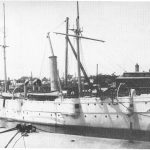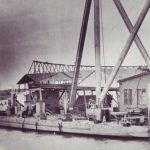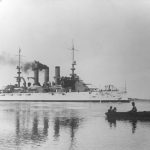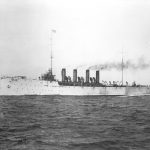More than a century ago there was keen interest in a ship’s speed, and strong competition to build the fastest vessel – even if only a fraction of a knot faster than a competitor. Shipbuilding contracts provided penalties for falling short of the designated contract speed, and sometimes rewards for exceeding it. With new and unproven technologies, and a new shipyard, there was a real question of how a ship would perform.
Thus there was intense interest, both inside the shipyard and in the community, when BIW’s first ship, the gunboat Machias, ran her sea trials in 1893. With a contract speed of 14 knots, she reached 14.47 knots on initial trials and 15.46 knots on acceptance trials, earning a bonus of $40,000. Her sister Castine surpassed 16 knots and was welcomed back by a city-wide celebration as she paraded up and down the waterfront.
Illustrating how quickly technology was evolving, just six years later BIW completed the torpedo boats Dahlgren and T.A.M. Craven, boasting a promised top speed of 30 knots. They ran their initial trials on the Kennebec River in Bath – apparently a common occurrence for small ships in the years before a bridge spanned the river – and were a source of entertainment for everyone along the waterfront as they raced upriver from Doubling Point.
In 1904 BIW launched the battleship Georgia, a major milestone for the company. At 435 feet long and 14,975 tons displacement, Georgia was the largest ship built in Maine until the 1960s. There was enormous public interest in the ship, with over 20,000 people attending the launching. That interest continued when Georgia returned to BIW after reaching 19.26 knots on sea trials, making her the fastest battleship in the US fleet. She was escorted upriver by a steamer carrying a band and 300 spectators, and welcomed to Bath by ringing church bells, cannons, and steam whistles throughout the city. This was followed by a parade through the city, speeches, and fireworks.
1909 saw the most complex sea trial of this era, as the BIW-built cruiser Chester competed head-to-head against two ships built at a competing yard. They were identical except for their propulsion plants, with Chester and one competitor featuring different types of steam turbines, while the third used traditional reciprocating steam engines. First the ships steamed side-by-side at various speeds to evaluate coal consumption, followed by a 24 hour high-speed endurance test. BIW’s Chester finished first with an average speed of 25.08 knots, 20 miles ahead of the second-place finisher, while the third ship broke down and dropped out. These trials firmly proved the superiority of turbine engines for high speed ships and BIW’s ability to build cutting-edge warships.




